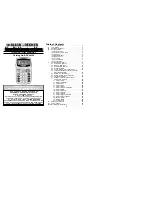
FEC920: USER GUIDE
Page 87
September 18
6.5.3 Wiring Example using a counter in combination with a totalizer
Figure 77 shows how a counter and totalizer can be linked in a real application using the internal (soft) wiring
in iTools. See also Section 9.3.
The application is to provide a running total of power being used by a process.
Figure 77 Linking a counter and totalizer
In this example
Channel 1 input is connected to a wattmeter.
Totalizer VC1 uses the period parameter to set the timescale of the units to hours. The UnitsScaler is set to
1000 to set the units of the total to Kilowatt-Hours.
Alarm 1 in VC1 is set as Absolute High and the Alarm Status output resets VC1 and increments the counter
VC3 by 1.
Math2 1 takes the output from VC1 and converts it into MegaWatt-Hours so that it can be added to the count
(also in MegaWatt-Hours) from VC2 to present a running total value.
Digital Input 1A1B is used to simultaneously reset both the count in VC2 and the total in VC1.
OR 1 is used to allow VC1 to be reset either by 1A1B or by the total reaching 1000.
Note:
Firmware version 5.00 uses 64 bit IEEE calculations. Inputs and outputs from the block as
wiring to and from other blocks is still in 32bit format, just like all other instrument parameters.
Inside the totalizer block these are converted to 64bits and processed in the 64bit domain
until their value has to be used by another block or has to be sent over comms, when it is
converted back to 32bits.
A5E45696052A Rev-AA











































